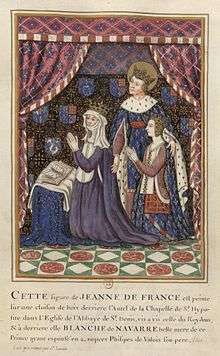Blanche of Navarre, Queen of France
| Blanche of Navarre | |
|---|---|
 Blanche with her daughter and Saint Louis | |
| Queen consort of France | |
| Tenure | 29 January 1349 – 22 August 1350 |
| Born | 1330 |
| Died |
1398 (aged 67–68) Neaufles-Saint-Martin, Normandy, France |
| Burial |
Basilica of St Denis Saint-Denis, France |
| Spouse | Philip VI of France |
| Issue | Joan of France |
| House | Évreux |
| Father | Philip III of Navarre |
| Mother | Joan II of Navarre |
| Religion | Roman Catholicism |
Blanche of Navarre (French: Blanche d'Évreux; 1330 – 5 October 1398) was Queen of France as the wife of King Philip VI.[1] She was the second child and daughter of Queen Joan II of Navarre and King Philip III of Navarre.[2] She belonged to the House of Évreux, a cadet branch of the House of Capet, and married into the House of Valois, another cadet branch of the House of Capet.
Life
At first, the Kings of Navarre wanted to achieve an alliance with Castile by having Blanche marry Peter, eldest son and heir of King Alfonso XI. However, Blanche was eventually betrothed to Prince John of France. As the most beautiful princess of her time — she was nicknamed the "Beautiful Wisdom" (Belle Sagesse)— Blanche captivated the recently widowed King Philip VI of France, father of her intended husband and almost forty years her senior. Their marriage on 29 January 1349 at Brie-Comte-Robert[2] alienated his son and many nobles from the king.[3]
The union was short-lived: King Philip VI died one year later, on 22 August 1350, according to some chroniclers of exhaustion from constantly fulfilling his conjugal duties. Pregnant at that time, Blanche gave birth a daughter, Joan (also named Blanche), in May 1351. After her husband's death, the Dowager Queen retired to Neaufles-Saint-Martin near Gisors in Normandy. Soon after, the now King Peter I of Castile asked her hand in marriage, but she refused the offer, saying: "The Queens of France never remarried" (Les reines de France ne se remarient point). She appeared in the French court on rare occasions, especially during the solemn entry of Isabeau of Bavaria in Paris, which was organized by her. Blanche also played a political role as a mediator between her brother King Charles II of Navarre and France.
In 1371, her only daughter Joan was engaged with John, eldest son and heir of King Peter IV of Aragon; however, she died during the journey to Aragon for her marriage on 16 September 1371 in Béziers.[4]
Death
Blanche died on 5 October 1398 at Neaufles-Saint-Martin. She is buried next to her daughter in the Basilica of St Denis, the necropolis of the Kings of France, north of Paris.
Ancestry
| Ancestors of Blanche of Navarre, Queen of France | ||||||||||||||||||||||||||||||||||||||||||||||||||||||||||||||||||||||||||||||||||||||||||||||||||||||||||||||||||||||||||||||||||||||||||||||||||||||||||||||||||||||||||||||||||||||||||||||||||||||||||||||||||||||||||||||||||||||||||||||||||||||||||||||||||||||||||||||||||||||||||||||||||||||||||||||||||||||||||||||||||||||||||||||||||||||||||||||||||||||||||||||||||||||||||||||||||||||||||||||||||||||||||||||||||||||||||||||||||||||||||||||||||||||||||||||||||||||||||||||||||||||||||||||||||||||||||||||||||
|---|---|---|---|---|---|---|---|---|---|---|---|---|---|---|---|---|---|---|---|---|---|---|---|---|---|---|---|---|---|---|---|---|---|---|---|---|---|---|---|---|---|---|---|---|---|---|---|---|---|---|---|---|---|---|---|---|---|---|---|---|---|---|---|---|---|---|---|---|---|---|---|---|---|---|---|---|---|---|---|---|---|---|---|---|---|---|---|---|---|---|---|---|---|---|---|---|---|---|---|---|---|---|---|---|---|---|---|---|---|---|---|---|---|---|---|---|---|---|---|---|---|---|---|---|---|---|---|---|---|---|---|---|---|---|---|---|---|---|---|---|---|---|---|---|---|---|---|---|---|---|---|---|---|---|---|---|---|---|---|---|---|---|---|---|---|---|---|---|---|---|---|---|---|---|---|---|---|---|---|---|---|---|---|---|---|---|---|---|---|---|---|---|---|---|---|---|---|---|---|---|---|---|---|---|---|---|---|---|---|---|---|---|---|---|---|---|---|---|---|---|---|---|---|---|---|---|---|---|---|---|---|---|---|---|---|---|---|---|---|---|---|---|---|---|---|---|---|---|---|---|---|---|---|---|---|---|---|---|---|---|---|---|---|---|---|---|---|---|---|---|---|---|---|---|---|---|---|---|---|---|---|---|---|---|---|---|---|---|---|---|---|---|---|---|---|---|---|---|---|---|---|---|---|---|---|---|---|---|---|---|---|---|---|---|---|---|---|---|---|---|---|---|---|---|---|---|---|---|---|---|---|---|---|---|---|---|---|---|---|---|---|---|---|---|---|---|---|---|---|---|---|---|---|---|---|---|---|---|---|---|---|---|---|---|---|---|---|---|---|---|---|---|---|---|---|---|---|---|---|---|---|---|---|---|---|---|---|---|---|---|---|---|---|---|---|---|---|---|---|---|---|---|---|---|---|---|---|---|---|---|---|---|---|---|---|---|---|---|---|---|---|---|---|---|---|---|---|---|---|---|---|---|---|---|---|---|---|---|---|---|---|---|---|---|---|---|---|---|---|---|---|---|---|---|---|---|---|---|---|---|---|---|---|---|---|---|---|---|---|---|---|---|---|---|---|---|---|---|---|---|---|---|---|---|---|---|---|---|---|---|---|---|---|---|---|---|---|---|---|---|---|---|---|---|---|---|---|---|---|---|---|---|---|---|
| ||||||||||||||||||||||||||||||||||||||||||||||||||||||||||||||||||||||||||||||||||||||||||||||||||||||||||||||||||||||||||||||||||||||||||||||||||||||||||||||||||||||||||||||||||||||||||||||||||||||||||||||||||||||||||||||||||||||||||||||||||||||||||||||||||||||||||||||||||||||||||||||||||||||||||||||||||||||||||||||||||||||||||||||||||||||||||||||||||||||||||||||||||||||||||||||||||||||||||||||||||||||||||||||||||||||||||||||||||||||||||||||||||||||||||||||||||||||||||||||||||||||||||||||||||||||||||||||||||
References
- ↑ Patrick Van Kerrebrouck, Les Capetiens 987-1328, Villeneuve d'Ascq, 2000,184.
- 1 2 Marguerite Keane, Material Culture and Queenship in 14th-century France: The Testament of Blanche of Navarre (1331-1398), (Brill, 2016), 43-44.
- ↑ Mortimer, Ian (2008). The Perfect King The Life of Edward III, Father of the English Nation. Vintage. p. 276.
- ↑ Marguerite Keane, Material Culture and Queenship in 14th-century France: The Testament of Blanche of Navarre (1331-1398), 2-3.
External links
| Blanche of Navarre, Queen of France Cadet branch of the Capetian dynasty Born: 1330 Died: 1398 | ||
| French royalty | ||
|---|---|---|
| Preceded by Joan of Burgundy |
Queen consort of France 1349–1350 |
Succeeded by Joanna I of Auvergne |